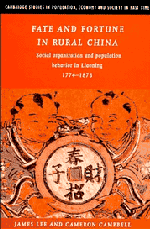Book contents
- Frontmatter
- Contents
- List of figures
- List of maps
- List of tables
- Acknowledgements
- PART 1 DAOYI VILLAGE
- PART 2 THE LIAONING DEMOGRAPHIC SYSTEM
- PART 3 HOUSEHOLD ORGANIZATION AND POPULATION BEHAVIOR
- 6 Domestic cycle and household formation
- 7 Domestic hierarchy and demographic privilege
- PART 4 BANNER ORGANIZATION AND POPULATION BEHAVIOR
- EPILOGUE: PROSPECTS, IMPLICATIONS, AND COMPARISONS
- Appendices
- Glossary
- References
- Index
- Cambridge Studies in Population, Economy and Society in Past Time
7 - Domestic hierarchy and demographic privilege
Published online by Cambridge University Press: 20 October 2009
- Frontmatter
- Contents
- List of figures
- List of maps
- List of tables
- Acknowledgements
- PART 1 DAOYI VILLAGE
- PART 2 THE LIAONING DEMOGRAPHIC SYSTEM
- PART 3 HOUSEHOLD ORGANIZATION AND POPULATION BEHAVIOR
- 6 Domestic cycle and household formation
- 7 Domestic hierarchy and demographic privilege
- PART 4 BANNER ORGANIZATION AND POPULATION BEHAVIOR
- EPILOGUE: PROSPECTS, IMPLICATIONS, AND COMPARISONS
- Appendices
- Glossary
- References
- Index
- Cambridge Studies in Population, Economy and Society in Past Time
Summary
All relations between the family members are regulated in detail by custom. The seniors occupy honorable places and exercise great influence until they fall into senility or complete physical debility. They are always honored by the expression of general attention. They are served at the tables with the best pieces of food, sometimes even separate tables are put up for them and special dishes are prepared.
(Shirokogoroff 1926:98)In Liaoning the myth of the large peasant household was a reality. The vast majority of the rural population lived in complex households with more than one conjugal family unit.
The hierarchical nature of such households defined the social and economic context of their daily life. Household structure determined the composition of the family work force. Household position determined access to family rights and resources. Household parentage determined the probability of rising to headship in their own right. All decisions from the commonplace—when they could eat, what they could wear—to the extraordinary—who they could marry, when they could have children—had to be negotiated within the household.
And yet with the exception of Arthur Wolfs pioneering analysis of nuptiality and fertility in Taiwan there has been little attempt to differentiate demographic patterns by specific family relationships.
In this chapter we reconstruct such patterns for the 2,000 unique peasant households (10,000 household observations) in our population. The chapter is divided into three sections. In section I, we summarize the formal structure and hierarchy of family relationships and outline the theoretical lines of authority within these multiple-family households.
- Type
- Chapter
- Information
- Fate and Fortune in Rural ChinaSocial Organization and Population Behavior in Liaoning 1774–1873, pp. 133 - 156Publisher: Cambridge University PressPrint publication year: 1997

